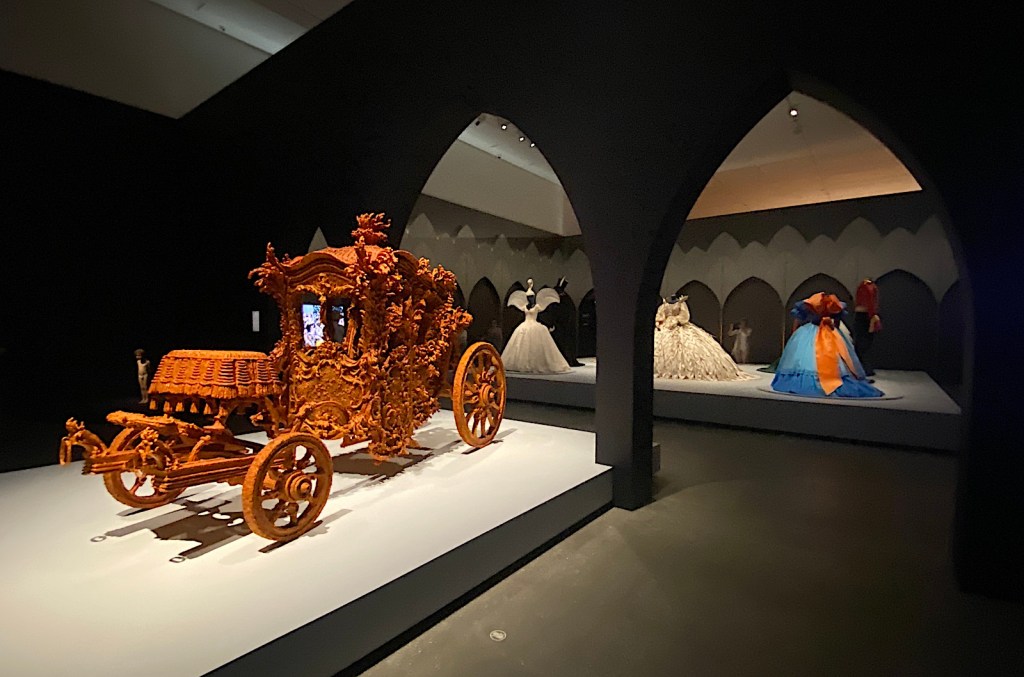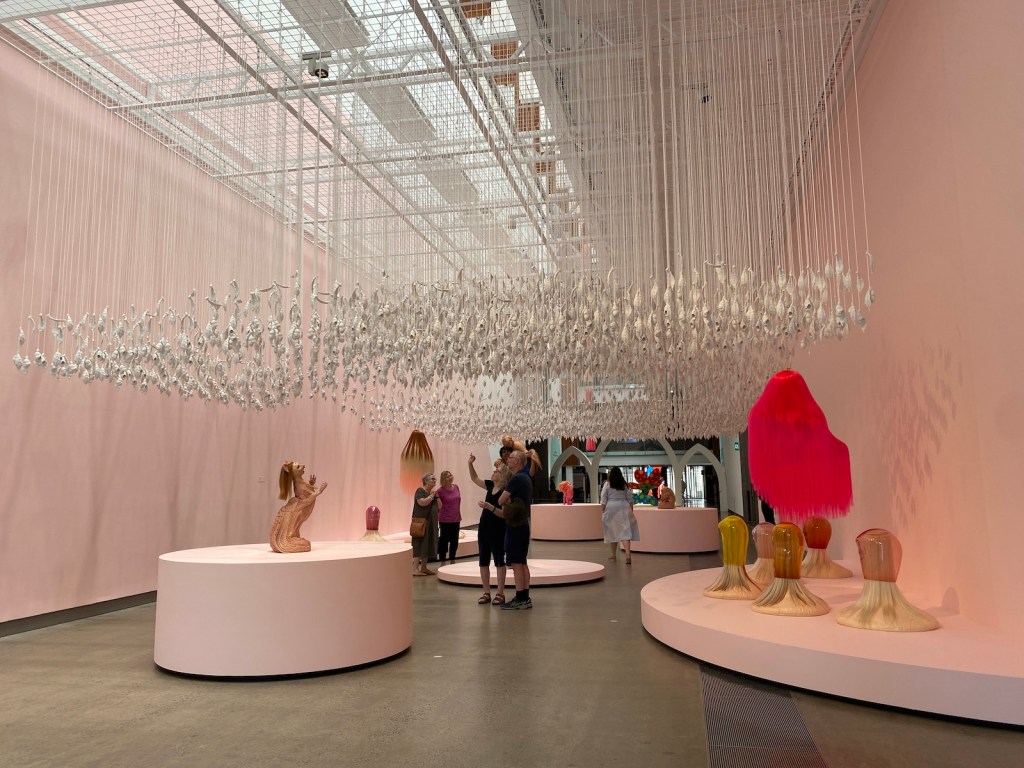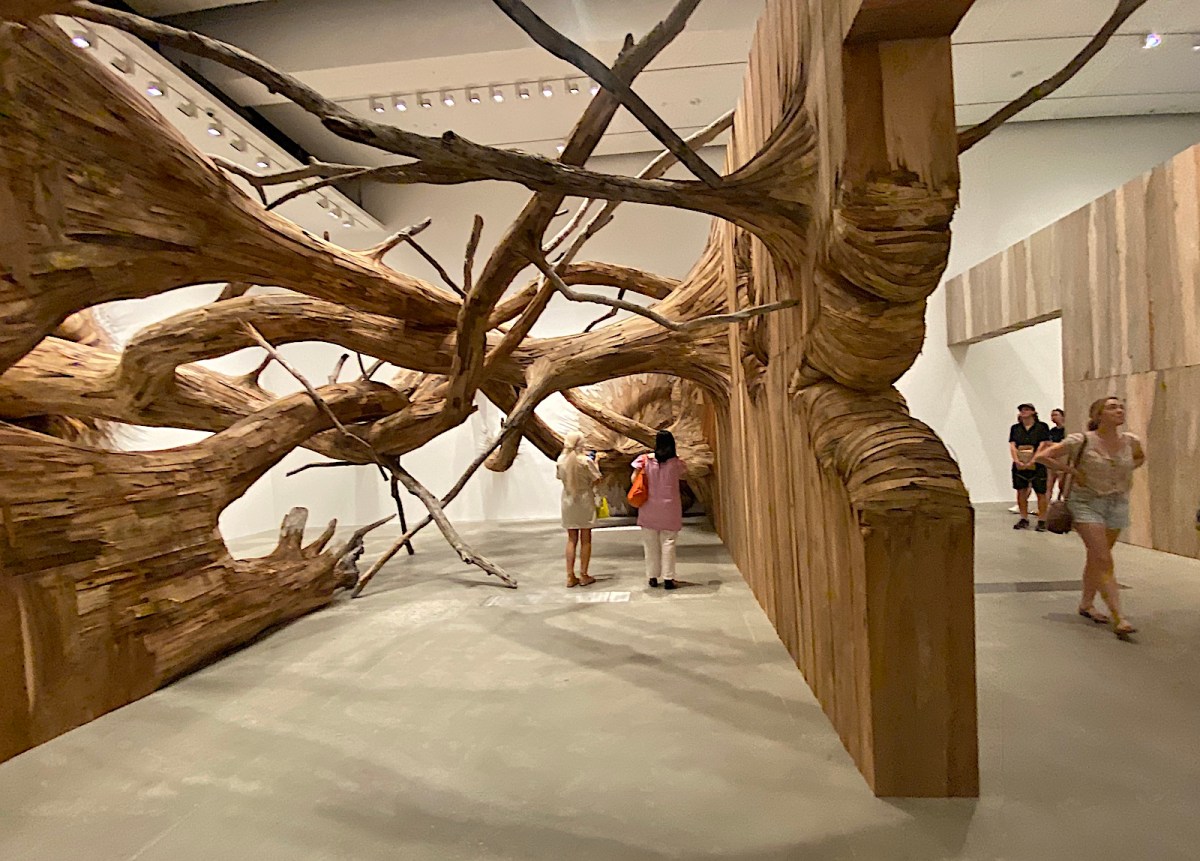This exhibition has a congested quality, one I would ordinarily critique as a negative gallery experience. However, in the exhibition Fairy Tales – which has just opened at Brisbane’s Gallery of Modern Art (GOMA) – that congestion is in keeping with, and almost a metaphor for, the foreboding that is the very essence of fairy tales.
We all grew up with them and, despite a world that has changed drastically since the Brothers Grimm were first penning their dark life lessons via bewitching tales, fairy tales have remained persistent. Indeed, this exhibition demonstrates that they are as popular as ever.
At the exhibition’s opening, the two lower galleries at GOMA were buzzing with visitors of all ages, leaning in to read labels, sitting watching snippets of films or salivating over iconic objects, such as Cinderella’s glass slipper (2015), made from Swarovski crystal and on loan from The Walt Disney Company.
Within sight of it is Timothy Horn’s Glass slipper (ugly blister), 2001, X from his Cinderella Complex series, which questions gendered ideals of romance with Baroque verve. This is one of the successes of this exhibition, where over 100 objects, paintings and installations that have shaped contemporary art history – and often gender politics in the arts – rub shoulders with the origins of those tropes via film.
It is a carefully curated journey on which viewers are led by exhibition curator, and Curatorial Manager of QAGOMA’s Australian Cinémathèque, Amanda Slack-Smith, and is expanded with a film program curated by Dr Sophie Hopmeier, Assistant Curator, Australian Cinémathèque. While a filmic component is often an adjunct aspect to QAGOMA programming, for this exhibition it is inseparable, with props and costumes making their way into the “white cube”.
Read: Exhibition review: NGV Triennial 2023
What this does is offer a non-hierarchical take on the theme. Contemporary artworks by some of the world’s top visual artists – Anish Kapoor, Kiki Smith, Urs Fischer, Trulee Hall, Carsten Höller and Ron Mueck, for example – sit alongside frocks from movie sets.

There is also a timelessness to this exhibition. For example, there is Charles Blackman’s much loved series on Alice in Wonderland from the 1950s, Destiny Deacon’s politically alert Oz series from the late 1990s, Tracey Moffatt’s Invocations series from 2000 and then the earliest painting in the exhibition, Gustave Doré’s Little Red Riding Hood (c. 1862). The latter is placed next to Kiki Smith’s Born (2002), a feminist take on the tale where an empowered Riding Hood pins down the wolf.
Francis Alÿs’ The Nightwatch (2004), meanwhile, captures a fox loose in the museum on CCTV, while an image by Abdul Abdullah, Troubling the margins (from the Interloper series) (2022), sees him imbue the image of a fox with a kind of gangster cool, disrupting hierarchies. Clearly, the curators have had fun drawing these connections, and they are smart and savvy weaving their own mythical tales of contemporary connections.
There are three chapters to the exhibition – in keeping with the notion of a tale – the first being ‘Into the Woods’, which is dimly lit and haunting. Visitors walk into the exhibition – as they would journey into the woods – and see the gallery walls slowly being taken over by a writhing installation of branches. Brazilian artist Henrique Oliveira’s new commission Curupira (2023) is a jaw-dropper, fashioned from salvaged timber.
And just as fairy tales lead you deeper along a path, so too does this exhibition, each room becoming increasingly darker. Viewers are introduced to loaded artworks, such as Jana Sterbak’s glass coffin Inside (1990/2023) and Trulee Hall’s darkly theatrical Witch House (Umbilical Coven) (2023), which visitor can enter.

Next is the chapter ‘Through the Looking Glass’, which is shaped out by puppets and props from Jim Henson’s landmark film Labyrinth (1986), on to a reimagined Enchanted Field (2023), Patricia Piccinini’s 3000 genetically modified blooms, which have moved from being floor-based to being suspended overhead in the atrium between the two galleries, and eventually on to a participatory, kinetic artwork Flying Mushrooms (2015) by Carsten Höller.
The final theme plays out the fairy tale classic of ‘Ever After’, and unpacks the layered roles of love in mythic proportions. Central to this narrative is Timothy Horn’s Mother-load (2008), a sumptuously embellished stagecoach created from crystallised rock sugar, and Kathryn Del Barton’s dark and stunning animated film, The Nightingale and the Rose (2015). It is a harrowing tale of love and death – the polar truths of fairy tales across time.
The exhibition concludes with a display of Eiko Ishioka’s elaborate costumes for the 2012 film Mirror Mirror, a Hollywood version of ‘Snow White’, which is screening alongside the costumes.
Read: Your 2023-2024 summer exhibition planner
Overall, Fairy Tales is deliciously layered and interconnected. It is exhausting – it is exhilarating – and it is the absolute perfect exhibition for broad summer viewing. The programming around this exhibition is huge, and definitely also worth a look also.
Fairy Tales
Exhibition Curator: Amanda Slack-Smith
Film Program Curator: Dr Sophie Hopmeier
Gallery of Modern Art, Brisbane
2 December 2023 – 28 April 2024
Ticketed.
ArtsHub travelled to Brisbane as a guest of QAGOMA.





